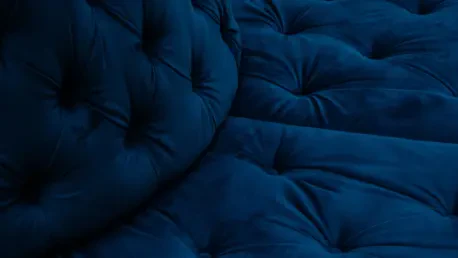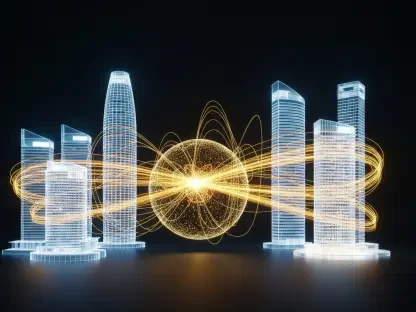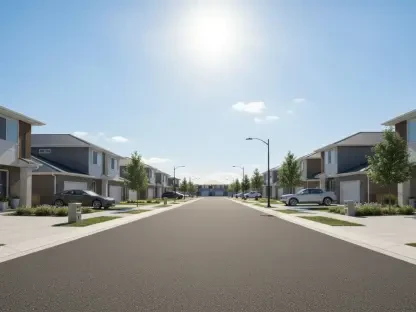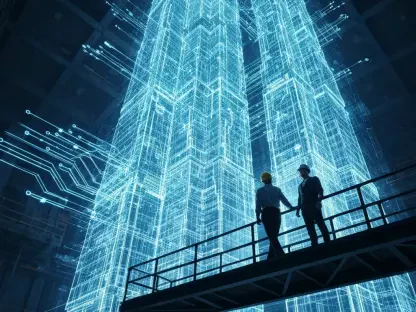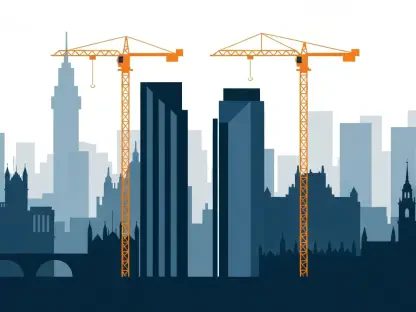In the dynamic realm of design, baby blue has emerged as a dominant force, shedding its past association with children’s rooms and powder spaces. The evolution of this color has sparked intrigue among designers and trendsetters alike, positioning it not only as a staple in the world of fashion but also as a crucial element in interior design. This soft hue captivates with its newfound popularity, perfectly aligning with contemporary aesthetic trends that embrace sophistication and understated elegance. Baby blue, once considered too delicate for mainstream use, now commands attention and admiration due to its adaptability and wide appeal in creating chic, serene environments.
The Transformation of Baby Blue
Historically, baby blue was synonymous with nurseries and powder rooms, its use largely confined to settings designed for softness and playfulness. Over time, however, perceptions shifted, driven by a desire to explore color theory more deeply and expand traditional boundaries within interior design. This transformation saw baby blue transition from juvenile and pastel-heavy spaces into well-appointed, mature settings. It became a color choice that signified polished sophistication, replacing its earlier one-dimensional depiction with more complex interpretations that infused settings with warmth and a subtle flair. Designers began to recognize baby blue’s potential as an elegant alternative to starker hues, thus broadening its application beyond youthful spaces.
Influential designers and stylists played a significant role in redefining the image of baby blue, as their innovative approaches showcased the color’s versatility when incorporated into upscale environments. By integrating baby blue into fabrics, accessories, and even architectural details, the design community has demonstrated its effectiveness in elevating spaces. No longer relegated to secondary roles, this hue is embraced in living rooms, bedrooms, and entrance areas where elegance and sophistication are key. These creatives illustrate that baby blue, when deployed thoughtfully, serves as an effective backdrop or accent that enriches spaces without overwhelming other design elements. Such transformations reveal the nuanced capabilities of baby blue within modern aesthetics.
Versatility and Sophistication
In both fashion and interior design, baby blue is distinguished by its compatibility with diverse color palettes and materials. Its ability to blend seamlessly with other tones highlights its versatility and adaptability, two qualities that have enabled the color to enjoy substantial popularity among designers and homeowners. Whether paired with natural hues for a soothing effect or contrasted with bold patterns and textures for a more dynamic look, baby blue offers layers of creative potential. This inherent flexibility extends from structures to fabrics, allowing it to be used in various applications without sacrificing its sophisticated appeal or serene properties.
The refreshing aura and optimism conveyed by baby blue have further contributed to its widespread appeal as a choice for contemporary design settings. Often associated with clearness and serenity, the color encourages a sense of calm yet invigorates with its fresh brightness. Design professionals and enthusiasts alike have turned increasingly to baby blue as they seek new ways to enliven spaces, moving away from traditional neutrals in pursuit of vibrant yet subtle hues that invigorate environments. This trend reflects changing preferences in global aesthetic sensibilities, where balancing color is key to achieving emotionally resonant living spaces that embrace modern ideals.
Capturing Calmness and Clarity
Baby blue offers a sense of calm and clarity that enhances mood and spatial dynamics, making it an ideal choice for crafting open and inviting environments where tranquility is desired. These spaces might range from coastal-inspired living rooms to meditation areas, where the user experience must prioritize relaxation and a sense of expansiveness. The gentle nature of baby blue introduces an emotional softness that can mitigate stress, foster connection, and improve well-being within the home. This color effortlessly supports the modern design philosophy that sees muted shades as pathways to deeper engagement with personal and public spaces.
The proliferation of baby blue in design publications and across social media platforms reflects broader trends favoring pastel tones and serene decor. When observers and influencers highlight baby blue’s aesthetic impact in finished projects, they underscore the rising popularity of design choices prioritizing visual calm and subtlety over cluttered intensity. This shift corresponds with a universal inclination toward creating environments that offer respite from everyday noise and chaos. In promoting baby blue, both virtual and print media have amplified its reputation, showing how an unexpected color can become a model for harmonious, reflective design.
Adaptability Across Styles
A testament to baby blue’s versatility is its capacity to transcend boundaries, seamlessly adapting to various design styles, whether traditional or contemporary. From period drawing rooms adorned with ornate decor to sleek, minimalist kitchens favoring clean lines and simple finishes, baby blue emerges as a compelling choice without losing its distinctiveness. This adaptability provides a refreshing alternative to more conventional neutral tones like beige or gray, known for their undue repetition or lack of vibrancy. The gentle infusion of color baby blue offers adds dimension and sophistication to spaces that might otherwise lack character or warmth.
Insightful designers like Sean Symington and Alexandra Keith have praised baby blue’s functionality within diverse design layouts. By advocating for creative uses of the color beyond its customary boundaries, these professionals reveal its previously underappreciated potential as a versatile element in home decor. Their designs often feature baby blue in combinations with deep blues, whites, and wood tones, showcasing its compatibility with different materials. Such endorsements challenge the perceived limitations of what baby blue can achieve in an environment, promoting its adoption in stylish yet relaxed settings where individual creativity enhances design integrity.
Innovative Pairings and Practical Insights
In the ever-evolving world of design, baby blue has risen to prominence, redefining its utility beyond traditional settings like nurseries and powder rooms. This transformation has captured the attention of designers and fashion influencers, making baby blue a vital component not just in wardrobes but as a significant player in interior design schemes. The soft yet striking hue has gained momentum in its popularity and now aligns seamlessly with modern aesthetic trends that emphasize sophistication and subtle elegance. Once thought to be too delicate or niche for widespread use, baby blue has proven its versatility and universal appeal, becoming a favored choice for crafting chic and tranquil spaces. Its ability to adapt to various design contexts allows it to stand out in contemporary aesthetics, where it is lauded for its ability to convey calmness while maintaining a stylish edge. Whether in high fashion or home decor, baby blue is recognized and appreciated for its role in setting a serene yet elegant tone.
